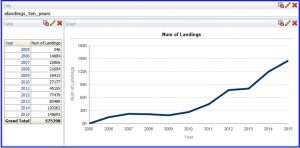
Ten years; 500,000 landing reports.
Fisheries managers, fishers, and seafood processors across the state of Alaska are celebrating those two milestones this month for the innovative Interagency Electronic Reporting System, better known as eLandings.
Responding to industry requests for electronic reporting, staff from NOAA Fisheries, the Alaska Department of Fish and Game, and the International Pacific Halibut Commission worked together and with industry members to develop a robust and agile reporting system to meet current and future reporting requirements for the agencies and industry. The result was eLandings—a more efficient, accurate, and timelier method for fishery reporting.
“These milestones represent more than just numbers,” said IPHC Executive Director Bruce Leaman. “They represent a major increment in data capabilities for the eLandings team members at ADF&G, NOAA Fisheries, and the IPHC. The system has also replaced inefficient and duplicative reporting requirements for our industry and allowed both the agencies and the industry to significantly reduce costs.”
The three agencies kicked off eLandings ten years ago to bring Alaska fisheries reporting into the modern era, and consolidate reporting to three fishery management agencies. The program was first implemented for the rationalized crab program in 2005. In subsequent years, eLandings was expanded to include Individual Fishing Quota sablefish and halibut, groundfish, and most recently, salmon.
Thanks to industry input, the reporting system has also expanded to include additional components, including an eLogbook to support electronic reporting from the at-sea fleet; tLandings for tendered groundfish and salmon vessels, observer fee reports, and the eLandings integrated Commercial Operators Annual Report. In addition, the system provides export of the information so that seafood processors can integrate the data with their own business tracking systems.
“eLandings has made a big improvement in the timeliness and quality of the information used in fisheries management” said ADF&G Commissioner Sam Cotten. “Electronic reporting has also enabled the department to reduce our printing and data entry costs, which is critical in today’s fiscal climate.”
According to a recent cost-benefits evaluation of eLandings, the reporting system has met the programs goals, including eliminating the requirements for industry to report the same information more than once. An additional benefit has been improved communication between the seafood industry and agency staff, as well as opportunities for the exchange of ideas regarding changes that could improve the system.
“We appreciate the collaboration we’ve had with industry, which has been key to making this program a success. Even after ten years, this electronic reporting tool is still cutting edge. Many other regions are just now exploring and implementing electronic reporting,” said NOAA Fisheries Alaska Regional Administrator Jim Balsiger. “The fact that we have a single reporting platform shared among three fisheries management agencies—one international, one federal, and one state—is especially unique.”
eLandings can be accessed at https://elandings.alaska.gov/
Source : NOAA Fisheries
[smoothcategory catg_slug=”at-sea”]
